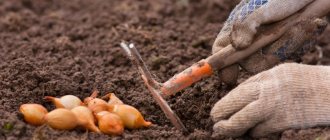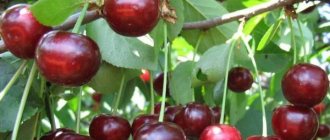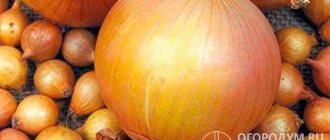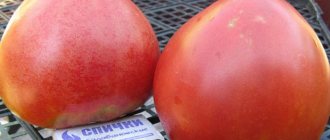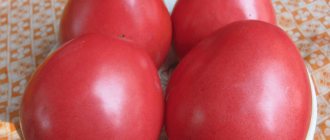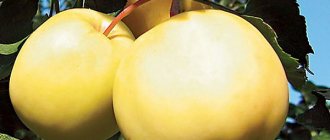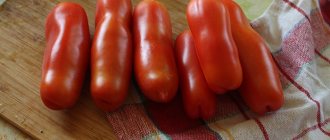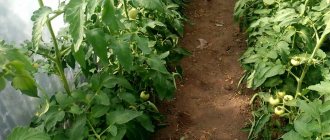History of selection
The Chuyskaya variety was obtained as a result of open pollination of wild sea buckthorn growing in the valley of the Chuya River. This is where the name of the cultivar comes from. When creating the variety, the Altai Scientific Center for Agrobiotechnology pursued the following goals:
- reducing the number of thorns on shoots;
- increase in productivity;
- improving fruit quality.
Breeding the Chuyskaya sea buckthorn took 18 years. In 1978, it was submitted for state variety testing. Below is a photo of Chuyskaya sea buckthorn.
In 1979, the variety was included in the State Register for the Northwestern, Far Eastern, Ural, Western Siberian and some other regions.
Reviews
Let's find out what gardeners and gardeners say about this sea buckthorn variety.
Our climate is cold, so I select fruit varieties for my dacha very carefully. First I read reviews, ask the opinions of experienced gardeners, and only then make a purchase. This is how I got Chuyskaya sea buckthorn.
I planted it five years ago, and now I’m already harvesting with all my might. I like the variety: it is unpretentious, does not freeze in winter, and produces delicious berries. Care is required, of course, but nothing supernatural.
Galina Sergeevna, Penza:
I’ve been wanting sea buckthorn for a long time, I’ve heard a lot about the benefits of this berry. But I didn’t know which variety to choose and where to get a seedling. I found it from friends and it turned out to be the Chuyskaya variety. I took several cuttings and they all took root. So I got as many as five sea buckthorn bushes, although initially I wanted only one. I have already been bearing fruit for two years, I really liked the berries - juicy and sweet.
Description of the berry crop
Sea buckthorn Chuyskaya is a deciduous shrub with a wide spreading crown. Grows up to 3 m in height. Used by many gardeners as a fruit variety. Can be grown in various climatic zones, from Kamchatka to Kaliningrad.
General idea of the variety
Chui sea buckthorn is usually formed in the form of a small multi-stemmed shrub. The crown is round, rather sparse, and not prone to thickening. The skeletal branches are clearly defined. The thickness of the shoots is average. The leaves are narrow, alternating, long, lanceolate. Their color on last year's branches is light green with a silvery tint, on the current year's shoots it is darker. The spines are weakly expressed, their number is insignificant.
Important! Chuyskaya sea buckthorn is not a self-fertile plant; a pollinator is required to obtain a harvest.
Berries
The size and number of Chuya sea buckthorn berries strongly depend on growing conditions. Basic data about the fruits is collected in the table.
| Parameter name | Meaning |
| Weight, g | 0,85–0,9 |
| Color | Bright orange |
| Form | Round-cylindrical, elongated |
| Length of the stalk, mm | 2–3 |
| Taste | Sweet and sour |
| Aroma | Expressive, pleasant |
| Sugar content, % | 6,4–7,2 |
| Berry detachment | Dry, light |
| Ripening time | Mid-late variety, harvest time – mid-late August |
| Productivity, kg | 10–11, with intensive agricultural technology – up to 23 |
Important! The yield and quality of Chuyskaya sea buckthorn fruits strongly depend on watering. Lack of moisture leads to fruit shrinkage and a halved yield.
Characteristic
The main characteristics of the sea buckthorn variety Chuyskaya are presented below.
Main advantages
The undoubted advantage of Chuyskaya sea buckthorn is its productivity. However, this cannot be achieved without good agricultural technology. This variety is especially sensitive to watering. Positive qualities are also:
- undemanding to soil composition;
- excellent winter hardiness (up to -45 degrees);
- slight thorniness of shoots;
- good taste of fruits;
- versatility of using berries;
- good transportability.
It should be noted that Chuyskaya sea buckthorn begins to produce crops already from the 3rd year of life, and it bears fruit consistently.
Flowering period and ripening time
The opening of buds and the ripening of Chuyskaya sea buckthorn strongly depend on the area of growth and weather conditions. In most regions, flowering time occurs in mid-May and lasts 6–12 days. Sea buckthorn berries of the Chuyskaya variety reach full maturity in the second half of August.
Area of application of berries
The berries of the sea buckthorn variety Chuyskaya are universal in their purpose. They can be consumed both fresh and processed. Most often, the fruits are dried, jams and jams are made from them, and the juice is squeezed out. Chuyskaya sea buckthorn can also be used to obtain sea buckthorn oil, but its content in the fruit does not exceed 2.9%. This is half that of technical varieties.
Resistance to diseases and pests
If the growing rules are followed, Chuyskaya sea buckthorn is rarely affected by diseases and pests. To prevent the occurrence of fungal infections, measures are taken to clean and thin the crown, and also treat the bushes with preparations containing copper. Insect pests are sprayed with special preparations.
Advantages and disadvantages of the variety
Chuyskaya sea buckthorn is not a clear leader compared to other varieties. There are more productive and sweeter ones. Rather, it can be called a strong middle peasant. It is not for nothing that this variety is the standard variety at the institute in many respects.
The positive qualities of Chuyskaya include its frost resistance, while the negative qualities include the strong dependence of the harvest on proper agricultural technology.
Sea buckthorn 'Dar MSU' and 'Chuyskaya'. Select, plant and grow sea buckthorn
'Gift of Moscow State University' - photo of a tree from my plot (found on several sites)) In the 50s of the last century, scientists closely studied the properties of different parts of sea buckthorn, they turned out to be too surprising and useful.
Scientific articles about the benefits of this plant began to appear. In the 70s and 80s, there was a sea buckthorn boom: summer residents planted sea buckthorn without delving into varietal accuracy. Then disappointment set in. The sea buckthorn was spreading throughout the garden, getting in the way, the shoots were too prickly, the harvest was not pleasing, and even if there was one, the berries turned out to be very small, sour, and picking them did not bring joy.
Now the time has come when you can buy any variety you like; dessert and sweet-sour varieties have appeared. The main thing: you need to choose the right variety for your area!
In the North-West, the climate is unstable. Frost-resistant and productive varieties of Altai selection immediately respond to spring temperature increases. Despite the fact that sea buckthorn is a frost-resistant crop and successfully tolerates -50°C, in some winters with thaws and repeated frosts, as well as during strong winds, the branches dry out. Male plants, whose flower buds freeze, are especially affected. As a result, we do not see the harvest. This was the case on our site until they changed the variety of the male specimen from 'Chuyskaya' to 'Dar MGU'.
For the Non-Black Earth Region of the North-West there are now interesting varieties - 'Golden Cob', 'Polivitaminnaya', 'Vladimirka', 'Popular', 'Dar Katuni' (the sea buckthorn 'Dar MGU' is close to it).
All varieties are good in their own way, but 'Dar MGU' is distinguished by its sweet-sour, and not vice versa, taste of large amber-orange berries hanging on a long, up to five mm, stalk. They come off easily and last a long time. The height of the plant reaches three meters, the branches are powerful and spreading. This variety is sometimes classified as a thornless variety, but there is no point in dissembling, there are thorns, albeit rare ones. Early ripening variety.
Thorns on 'Dara' As a rule, they crown the tip of the branch. The spines on the female tree 'Dara MGU' are female type buds. Sometimes there are thorns 1cm long growing directly from the buds. And next to it is a bent soft thorn. This variety has a lot of soft thorns. In any case, you need to pick berries carefully and carefully; you can easily get hurt. It is better to cut off such branches covered with berries, called “cobs”, as they will dry out by spring anyway. The yield of 'Dar MGU' reaches 20 kg by eight years, so there is no need to keep many trees on the plot. Now we have the third generation of sea buckthorn growing, obtained from maternal female plants using root shoots. Two female specimens and one male of the 'Dar MGU' variety are complemented by 2 bushes of the 'Chuyskaya' variety (it is also already in the third generation). The male copy cannot be updated as often as the female ones.
'Chuyskaya' - obtained as a result of selection of the best wild Chuy forms. Early ripening variety. The crown is sparse, spreading, up to three meters high. There are few thorns. The variety is productive, the berries are cylindrical, orange in color, and have a sweet and sour taste. The detachment is dry, the length of the stalk is up to three mm.
Thorns on 'Chuyskaya' Berries on young 'Chuyskaya'
Of course, it is much easier to collect such berries than those that cover the 'Gift of Moscow State University' branch in the first photo. Here you don’t have to cut branches or expose the crown. You can remove branches that point upward to reduce the crown.
The crows broke off a branch of a young sea buckthorn, sitting on it. Berries, collected a month apart. On the left side of the basin the “cobs” have dried up. The sea buckthorn fruits on the left are unripe, they remain that way, but have not deteriorated in a month. There was a basin on the veranda.
Landing rules
The rules for planting the Chuyskaya variety do not differ from those generally accepted for this type of plant. Sea buckthorn is planted in groups, since both female and male individuals are needed to obtain berries.
When planting, you need to take into account that adult bushes of the Chuyskaya variety will be quite tall, but the annual growth of seedlings is small.
Recommended timing
Most gardeners consider the best time to plant Chuyskaya sea buckthorn to be early spring. In the fall, after the leaves have fallen, excavation work can begin in the south. Sea buckthorn with a closed root system can be planted at any time except the hot summer months.
If the planting time is missed, it is better to bury the young trees of Chuyskaya sea buckthorn before spring. To do this, they are placed in a ditch 0.5 meters deep, directing the crown to the south. The roots are covered with earth, and after the first frost, all seedlings need to be covered, leaving only the top outside. Then a layer of spruce branches is laid on top, and after snow falls, an additional shelter is made from it.
Choosing a suitable location
Sea buckthorn Chuyskaya loves sunlight. It should be planted in an open space, at a distance of at least 2–3 m from other garden trees. There should be no garden beds nearby, otherwise when digging there is a high risk of damaging the shallow roots. Chuyskaya sea buckthorn should not be planted next to a high fence or garden buildings. You should also avoid places that may periodically be flooded or with a groundwater level above 1 m.
Soil preparation
It is better to prepare planting holes for Chuyskaya sea buckthorn in advance. The excavated fertile soil must be preserved. A nutritious soil mixture is made from it, which will fill the root system of the seedling. To prepare it, the following components are taken:
- compost or humus - 1 bucket;
- river sand – 1 bucket;
- fertile soil - 2 buckets;
- wood ash – 0.5 buckets;
- superphosphate – 0.2 kg.
All components must be mixed well.
Selection and preparation of seedlings
High-quality planting material is the key to a good harvest. It is best to choose bushes of the second year of life. By this time, the length of the plant should be 35–50 cm, and the roots should be at least 20 cm.
When choosing a Chuyskaya sea buckthorn seedling, you need to pay special attention to its bark. It should not peel off or be brown in color. This indicates that the seedling has been damaged by cold and will not be able to recover.
Algorithm and landing scheme
Chuyskaya sea buckthorn seedlings can be arranged in rows or in a checkerboard pattern. For high-quality pollination, the ratio of male to female trees should be no more than 1:5. Many gardeners reduce the proportion because male trees die more often. They are planted on the windward side of the group or surrounded by female specimens. The best pollinator for Chuyskaya sea buckthorn is a male tree of the same variety.
The planting holes should be no less than 2 m apart from each other. A support is driven into the bottom of each hole, offset from the center, to which the young tree will be tied. It is planted vertically, the roots are straightened and covered with a nutrient mixture, compacting the soil to prevent the formation of voids. The root collar should be at a height of 5–6 cm from ground level. The Chuyskaya sea buckthorn seedling must be tied to a support.
Important! After planting, be sure to do plenty of watering. After this, the soil can be mulched with grass or straw.
Subsequent care of the crop
Planting and caring for Chuyskaya sea buckthorn is not difficult. Unlike fruit trees, the trunk circle of sea buckthorn is not dug up, so as not to damage the closely lying roots.
Necessary activities
For proper formation of the bush, regular pruning will be required, and for good fruiting, maintaining soil moisture and sometimes fertilizing. Adult sea buckthorn Chuyskaya, especially in dry weather, will need regular watering. The entire root zone needs to be moistened. Once every three to four years, organic matter is added under the bush - a bucket of humus or compost mixed with a small amount of superphosphate.
In early spring, the bushes can be fed with nitrophoska, scattering it in the root zone.
Weeding and loosening of the trunk circles of Chuyskaya sea buckthorn is not carried out. Weeds are simply mowed down to the roots. It is best to mulch the tree trunk circle with turf. This not only reduces the risk of root damage, but also prevents pests and their larvae from emerging from the soil.
Shrub pruning
In the first three years, the Chuyskaya sea buckthorn bush is shaped by pruning. After planting, the seedling is shortened to 10–20 cm in height. The next year, several strong shoots are selected from the resulting root shoots, and the rest are removed. This will be the basis of the future bush. Carry out autumn and spring sanitary pruning, removing old, dry, broken and diseased branches.
Preparing for winter
Chui sea buckthorn is a very winter-hardy plant, so no preparatory measures are usually carried out before the winter period. To reduce the risk of damage by rodents, you can make a metal mesh fence around the bush and whitewash the stems. In addition, the tree trunk circle can be lined with spruce branches and covered with a layer of turf on top. This multi-layer cover serves as additional protection for the roots from freezing.
Unpretentious, but with character
Initially, Chuyskaya sea buckthorn was bred as an intensive variety, so in order for the branches to burst with berries, as shown in the photo below, it needs decent agricultural technology. Without this, it will not be possible to unlock the potential of culture.
From the moment of planting, the seedling should receive a lot of sun and should not be shaded by older or tall neighbors.
To ensure an intensive start, make a good supply of nutrients when planting - 10–15 kg of humus, 2 cups of wood ash, 100 g of double superphosphate.
Cultivated sea buckthorn needs the same varietal pollinator with highly productive pollen, for example, Alei. If it is a random male plant located somewhere within a radius of 200 m, do not count on an abundant large-fruited ovary.
Chuyskaya sea buckthorn is extremely sensitive to lack of moisture. In dry summers without watering, its fruits become 2 times smaller. With intensive cultivation technology, there should be at least 4 irrigations - during flowering, fruit filling, ripening, and moisture recharging (in autumn). If the summer is dry, you need to look at the condition of the soil and plants.
For high yields, annual fertilizing is needed. The shrub is especially responsive to organic matter and phosphorus. Humus (1–1.5 buckets) is added before winter or early spring, superphosphate (30–50 g/m²) – at the end of summer.
Diseases and pests, methods of control and prevention
Chuyskaya sea buckthorn has good immunity to diseases. However, in conditions of high humidity or severe neglect of the bushes, fungi may appear on the leaves and bark. The main diseases of sea buckthorn are given in the table.
| Name of the disease | Signs of appearance, consequences | Control and prevention measures |
| Verticillium wilt | Leaves and branches turn yellow and dry out. The plant dies. | The disease has no cure. The plant must be dug up and burned. |
| Black cancer | Characteristic black spots appear on the bark. At this point the bark cracks and flies off. The wood turns black. | Timely removal of foci of infection and treatment with copper sulfate. The sections are covered with a mixture of mullein and clay. |
| Blackleg | It appears as black rot of the trunk at ground level. The trunk rots and the tree falls. | Appears on young seedlings. It is recommended to plant them in a soil-sand substrate (1:1) and water them with a weak solution of potassium permanganate. |
| Septoria | The appearance of characteristic brown spots on the leaves with a colorless center. The plant sheds its leaves early and usually dies in winter. | Tear off and burn infected leaves. In early spring, spray the bushes with 1% Bordeaux mixture. |
| Brown spot | Brown spots appear on the leaves, then they merge. The leaves die. | The same as for septoria. |
| Nectria necrosis | It is detected by the bright red or orange pads of the fungus on the bark of the tree. | Affected shoots must be removed and burned. |
| Fruit rot | The berries become soft, wither and mummify. | Timely removal of dried berries. For prevention, the bush is sprayed with 1% Bordeaux mixture in spring and autumn. |
Insect pests also rarely attack Chuyskaya sea buckthorn. The table shows some of them.
| Pest name | What damages | Methods of control and prevention |
| Sea buckthorn fly | Berries with larvae developing in them | Preventive spraying with Fufanon, Iskra, Inta-Vir, etc. |
| Sea buckthorn aphid | Leaves, from which aphids suck the juice | -//- |
| Sea buckthorn moth | Caterpillars gnaw leaves | -//- |
| Spider mite | Sucks juice from leaves, buds and flowers. | -//- |
